

Source: ARK Invest
In 1997, Robert Greer proposed three asset classes in The Journal of Portfolio Management:
1. Capital assets: assets that can generate value/cash flow, such as stocks, bonds, etc.;
2. Consumable or convertible assets: can be consumed, burned or converted in one go, such as oil, coffee;
3. Value store assets: Value persists in time/space and is scarce, such as gold and Bitcoin.
In 2019, David Hoffman pointed out that Ethereum can be used as the above three assets at the same time: pledged ETH as capital assets, Gas as consumable assets, and ETH locked in DeFi as a store of value assets.
In the past five years, with the vigorous development of the Ethereum ecosystem, the utility of ETH has been continuously extended – intuitively reflected in ETH as the valuation unit of NFT, as the Gas Token of Ethereum Layer2, the valuation unit of MEV activities, as well as LST andDeFi derivatives built on LST and more.
Recently, EigenLayer has expanded the economic security of ETH to middleware and even other ecosystems such as Cosmos with the help of restaking, further strengthening the network effect of ETH.
Let’s summarize it briefly:
1. Pledged or re-staked ETH, including liquid pledged and re-staked tokens such as stETH and eETH, represents assets that can generate value/cash flow as capital assets;
2. ETH, as the Gas spent by Layer1 and Layer2, including Rollup’s data availability overhead in Layer1, overhead for verifying zero-knowledge proofs, etc., can be consumed and burned at one time, so it is regarded as a consumable asset;
3. ETH serves as the reserve asset of each protocol DAO vault, the collateral of CeFi and DeFi, as well as NFT transactions, MEV supply chain pricing, token trading reciprocating, respectively, as accounting units and mediums of exchange, and the value continues in time/space.Existence is a store of value assets.
Among them, staking is the core pillar of the Ethereum network.By allowing participants to lock in ETH and participate in the verification process, staking provides a strong economic incentive for the network, transforming Ethereum into a safer, more efficient and more sustainable blockchain platform, laying a solid foundation for its long-term development.
This article will provide systematic reports on the pledge and re-pled fields and their ecology, as well as the investment logic and perspectives accumulated by our investment layout in this track.

1.Staking (Staking)
1.1 Overview
The concept of “staking” was born before Ethereum.In 2012, in order to solve the problem of high energy consumption of Bitcoin mining, Peercoin took the lead in proof-of-Stake (PoS), and staking is one of the key attributes.
In the context of Ethereum, generally speaking, staking refers to running the validator software by locking 32 ETH on the Ethereum blockchain, thereby helping the Ethereum network verify transactions and maintain security, and obtaining certain ETH rewards.The process.
Currently, the annualized income of Ethereum staking is about 3.24%, provided by the issuance of ETH, and other income may come from Tips and MEV revenues from the Ethereum network.
1.2 Four forms of pledge
1.2.1 Solo Staking (single pledge)
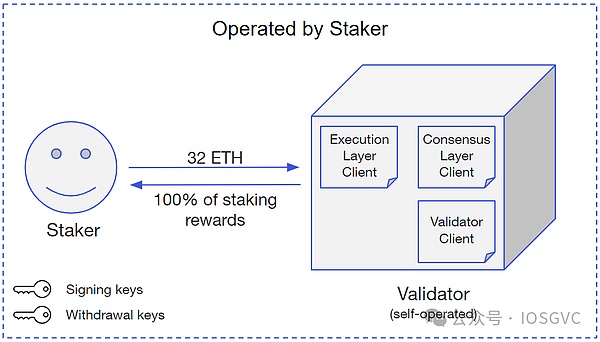
Source: ConsenSys
Separate pledge is the basic form in all pledge routes.The staker needs to deposit 32 ETH and run and maintain a complete Ethereum client to ensure the normal operation of the validator.Separate pledge is beneficial to improving the degree of decentralization of the network.
Ideally, since individual pledges are self-management and no service fees are required to be paid to any third party, the benefits are also the highest.However, compared with professional pledge services, individual pledges may also cause missed rewards or confiscations due to disconnection or malicious behavior, and coupled with operating and maintenance costs, the benefits may fluctuate.
The proportion of individual pledges is an important indicator of the degree of decentralization of Ethereum.According to a study conducted by rated, individual stakeholders accounted for approximately 6.5% of all Ethereum validators by the end of 2022.
Although separate staking is the key pillar for Ethereum to achieve decentralization, due to the funding requirements and operational thresholds of 32 ETHs, separate staking is difficult to become the mainstream.With the development of Ethereum’s staking, the following staking methods have been derived in the market.
1.2.2Staking Service Provider
In order to meet the scale development of the pledge track, pledge service providers usually provide large-scale and professional pledge services to institutional-level customers or high-net-worth individuals, and charge a certain percentage of fees based on the pledge income (based on the scale of funds participating in the pledge,5%-10% range).Companies such as Kiln and Figment are representatives of pledge service providers, with more than $8.6 billion in pledged assets powered by Kiln’s technology.
In addition to providing staking services for Ethereum, staking service providers basically cover the staking services of other PoS chains and also participate in the restaking services.
In addition to the B2B business model, the B2B2C business model is also an important part of these companies’ revenue.For example, Kiln partnered with mainstream wallets such as Ledger, Coinbase Wallet and Metamask to provide users of these wallets with a one-stop staking solution.Wallets provide distribution channels for pledge service providers, while the latter provides infrastructure and services for the former, sharing revenue between them.
1.2.3Centralized exchange pledge
Centralized exchange pledge is a pledge service provided by various centralized exchanges to their users. This type of pledge is custodian and requires almost no funding threshold. However, the disadvantage is that the fees are usually high and opaque, and there are risks such as misappropriation of funds.Coinbase, Binance and other companies are representatives of centralized exchange pledges.
The proportion of pledged shares on centralized exchanges has dropped from around 40% from 2021 to 2022 to 24.4% now.The reasons may be: First, after the fall of FTX, users’ trust in centralized and custodial solutions decreased; second, in February 2023, under the regulatory pressure of the US SEC, Kraken announced the termination of providing pledge services to US customers.This raises users’ concerns about pledge service providers within specific jurisdictions.Despite this, centralized exchange staking is still the second largest staking option after liquid staking.
1.2.4Liquid Staking (Liquidity Staking/LST)
LST is an application that is pledged at the protocol and smart contract levels.Protocols such as Lido collect ETH from the user side and outsource the business running the validator to a third-party staking service provider, and charge fees from it.
The main feature of LST is that these protocols usually return 1 equivalent tokenized claim to the user as a voucher (such as Lido’s stETH), thereby liberating the liquidity of funds.These credentials can be approximately considered ETH equivalent and can be used in multiple DeFi protocols for additional benefits.LST’s tokenized debt has a risk of deaning, but this risk is reduced after the “Shanghai Upgrade” Ethereum activation withdrawal.
Lido currently has the highest market share in LST, with TVL 12.9 times higher than the second-place Rocket Pool.In addition to Lido, some differentiated products have also been derived.
1. For example, compared with the professional staking service providers operated by Lido, Rocket Pool allows anyone to run validators for Rocket Pool’s stakers, with a total of 3,716 node operators, with better decentralization and capital efficiency..
2. When participating in pledge, institutions mainly consider three points: safety, liquidity and compliance.Traditional institutions need to make due diligence on counterparty risks and complete a series of KYC/AML and other compliance processes.At this stage, licenseless LSTs such as Lido cannot meet this type of demand.Alluvial, in conjunction with leading staking service providers such as Coinbase, has launched LST’s industry standard for institutions’ compliance needs: Liquid Collective, which mainly provides a “dedicated pool” that fully complies with KYC/AML requirements, which can better help traditions.Funds enter the Ethereum pledge market.

Source: GSR, IOSG
The above table summarizes the above content.
1.3 Summary
a. Looking back at the development of the pledge track, the emergence of LST has solved the above two major pain points of capital and operation, while further releasing liquidity.These three points are the primary reasons for Lido’s success.The quality of liquidity is directly related to the user’s psychological expectations and the degree of trust in the agreement.Lido has the best exit liquidity in the market before “Shanghai Upgrade” activates withdrawals, which is also the main reason why Lido can become the attracting new funds participating in pledges.When the competitive landscape of LST has been determined and fierce competition between LRTs began, Ether.fi established a market leadership position with a good liquidity pool, which also verified this.
b. Looking at the pledge market, Lido has long occupied a leading position with a market share of about 30%, and the head effect is quite obvious.Despite this, there are still some differentiated products in the market.For example, Liquid Collective’s compliant pledge solutions for more traditional institutional users; and the market opened up by the new narrative of re-pled—in fact, Ether.fi quickly attracted funds in the short term with the east wind of re-pled., the ETH deposits attracted by 1.21 million in the past six months, with a growth rate of 288.1%, becoming Ethereum’s third largest stakeholder, second only to Lido and Coinbase.
c. In addition to LST, we believe that pledge service providers are also good investment categories.LSTs like Lido are essentially middlemen of node operators connecting end users, playing a distribution role and relying on node operators to perform actual operations and operations.Compared to running nodes themselves, these node operators have scale-based cost advantages and high-level service guarantees.Whether it is cooperating with LST, re-staking agreements, etc. to run nodes, or helping wallet users participate in staking, node operators have a good ecological niche and solid business model.In addition, as validators, these node operators are key mounts in the on-chain transaction life cycle and have an important position.The recent Pre-confirmation (pre-confirmation) that appears on the market is one of the services that verifiers can provide.

2.Restaking (re-staking)
2.1 Overview
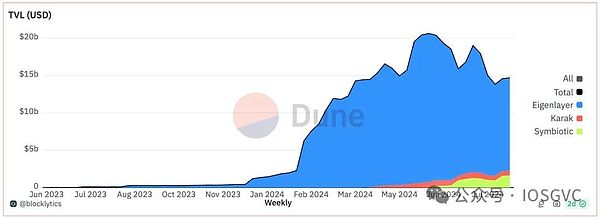
Source: ETH Restaking Dashboard by @blocklytics
Based on Ethereum pledge, the project represented by EigenLayer proposed re-staking – that is, the pledger performs a second pledge based on the original Ethereum pledge exposure, in order to promise to honestly provide economic security for middleware, andReceive profits accordingly; at the same time, the re-pled person needs to bear the risk of slashing the pledge exposure caused by factors such as improper operation.
In terms of market size, EigenLayer surpassed Uniswap and AAVE shortly after the mainnet went online, quickly becoming the second largest DeFi protocol after Lido.As of now, EigenLayer’s TVL has reached US$15.5 billion, three times that of Uniswap, with 19 AVS and 339 node operators running on the main network.
In addition to EigenLayer, Symbiotic, a re-staking protocol supported by Lido and Paradigm, has also been launched on the market.Symbiotic is a restaking solution powered by Lido and Paradigm.On the asset side, Symbiotic accepts any ERC-20 token or LP position as re-pending assets.So far, Symbiotic’s TVL has reached 1.2 billion US dollars, mainly composed of ETH-based LST and stablecoins.
This chapter will be discussed mainly based on EigenLayer.
2.2EigenLayer
Before EigenLayer, middleware in the Ethereum ecosystem had obvious pain points:
-
To become a middleware verifier (node operator), you need to invest money first.For the sake of token value capture, validators are often required to pledge the middleware’s native token, which requires a certain marginal cost, and due to the fluctuation of token prices, there is uncertainty in their exposure, and even the token falls.The losses caused may be much greater than the benefits obtained.
-
And the project party needs to maintain a certain token value, otherwise rational funds will be moved to other platforms or protocols with higher returns.Secondly, the security of middleware depends on the overall value of the pledged token; if the token plummets, the cost of attacking the network will also decrease.This problem is particularly prominent in early stages of the project and the token value is low.
-
For some middleware-dependent dApps (such as derivatives that require oracle feeding prices), their security actually depends on both Ethereum and middleware’s trust assumptions.This creates a barrel effect – system safety depends on its shortcomings.
These are the basic issues that EigenLayer wants to solve.
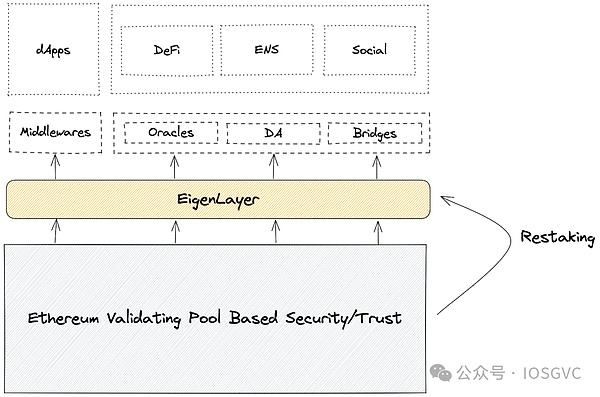
Source: EigenLayer, IOSG
EigenLayer solves the above problem by introducing re-staking: re-staking is carried out by existing stakeholders on Ethereum, which means that there is no need to invest additional funds, but instead expands the existing ETH staking share to a new agreement (of course, it is necessary to invest additional funds)., which introduces new exposures and assumptions), and the price of ETH is relatively stable, making ETH-based economic security more reliable.
The project party can adopt a double staking model, that is, the verifier pledges the native token and ETH at the same time. While ensuring that the token’s utility is not sacrificing, it also avoids the death spiral caused by the decline in the price of a single token.At the same time, Ethereum validators are also more decentralized.
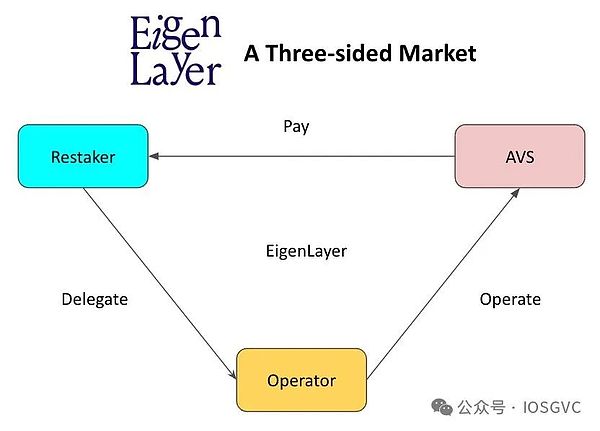
Source: IOSG
Structurally, EigenLayer is a tripartite market:
-
AVS (Actively Validated Service).That is, cross-chain bridges, oracles and other infrastructures.As a consumer of economic security, AVS is guaranteed by economic security and pays to re-pledgers.
-
Re-pled.Reprivate with ETH exposure can participate by transferring their staking withdrawal vouchers to an EigenLayer smart contract, or simply depositing them into an LST (such as stETH).If the restakers cannot run the AVS node, they can delegate their task to the operator.
-
Operator.The AVS node is run by an operator entrusted by the restaker, or provides verification services.The operator can choose which AVS to serve.Once service is provided for AVS, the confiscation rules set by AVS must be followed.
The following figure summarizes the ways and workflow of participating in restaking on EigenLayer.
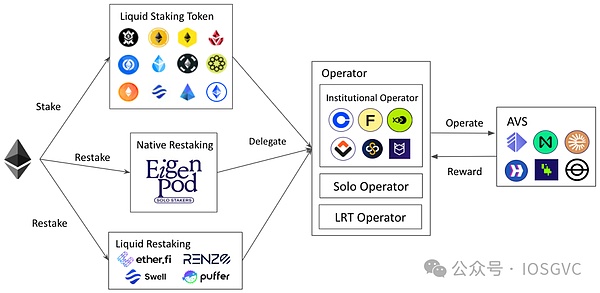
Source: IOSG
EigenLayer provides the following three programmable trusts:

Source: EigenLayer
-
Economic Trust: Economic Trust depends on people’s confidence in pledged assets.If the profits brought by corruption are lower than the cost of corruption, economically rational actors will not attack.For example, if the cost of launching an attack on a cross-chain bridge is $1 billion but the profit is only $500 million, it is obviously irrational to conduct an attack from an economic perspective.As a widely adopted crypto-economic primitive, confiscation can greatly increase the cost of corruption and thus strengthen economic security.
-
Decentralized Trust: The essence of decentralized trust is to have a huge and widely distributed collection of validators, both virtually and geographically.To prevent collusion and Liveness Attack between individual nodes in AVS, it is best not to have a single service provider run all nodes.On EigenLayer, different AVSs can customize their decentralization level.For example, they can set geographic location requirements for node operators, or only allow individual operators to provide node services and provide more incentives accordingly to attract such operators.
-
Ethereum “Inclusion” Trust: In addition to making a commitment to Ethereum through staking, Ethereum validators can also make trusted commitments to AVS if they are further restaking on EigenLayer.This allows the proposer to provide some services on Ethereum (for example, partial block auctions via MEV-Boost++) without making changes to Ethereum’s protocol level.For example, forward block space auctions allow buyers to ensure that future block space is obtained in advance.Verifiers participating in restaking can make trusted commitments to the block space and will be confiscated if they do not include the buyer’s transactions later.
Economic Trust: Economic Trust depends on people’s confidence in pledged assets.If the profits brought by corruption are lower than the cost of corruption, economically rational actors will not attack.For example, if the cost of launching an attack on a cross-chain bridge is $1 billion but the profit is only $500 million, it is obviously irrational to conduct an attack from an economic perspective.As a widely adopted crypto-economic primitive, confiscation can greatly increase the cost of corruption and thus strengthen economic security.
Decentralized Trust: The essence of decentralized trust is to have a huge and widely distributed collection of validators, both virtually and geographically.To prevent collusion and Liveness Attack between individual nodes in AVS, it is best not to have a single service provider run all nodes.On EigenLayer, different AVSs can customize their decentralization level.For example, they can set geographic location requirements for node operators, or only allow individual operators to provide node services and provide more incentives accordingly to attract such operators.
Ethereum “Inclusion” Trust: In addition to making a commitment to Ethereum through staking, Ethereum validators can also make trusted commitments to AVS if they are further restaking on EigenLayer.This allows the proposer to provide some services on Ethereum (for example, partial block auctions via MEV-Boost++) without making changes to Ethereum’s protocol level.For example, forward block space auctions allow buyers to ensure that future block space is obtained in advance.Verifiers participating in restaking can make trusted commitments to the block space and will be confiscated if they do not include the buyer’s transactions later.
2.3Babylon
(Conceptually, Babylon does not belong to “re-staking”, but is a Bitcoin “staking”, but because its use cases are similar to EigenLayer, it provides economic security for blockchain, middleware, etc., so it is included in this chapterdiscuss)
Babylon’s launch is based on the background that Bitcoin cannot generate “native” returns due to the programmability of the Bitcoin blockchain.Generally speaking, there are two main ways for Bitcoin to generate returns:
-
Packaging Bitcoin.A WBTC-like solution issuing WBTC on Ethereum through a 1:1 acceptance method, allowing Bitcoin to participate in a variety of DeFi activities on Ethereum in a mapped way.Currently, the size of WBTC is around 10 billion US dollars.However, such solutions are usually based on multi-signature and trustee mechanisms, and have a high degree of centralization.
-
Deposit to a centralized exchange.Financial management products of centralized exchanges provide the benefits of Bitcoin.However, the returns are often opaque and have great financial risks.
Babylon introduces native Bitcoin staking on the Bitcoin blockchain without relying on any third-party custody, packaging and cross-chain bridges..This technical mechanism is Babylon’s technological innovation, which releases the utilization value of idle Bitcoin and provides an extremely important infrastructure for the Bitcoin ecosystem.
The following figure summarizes the ways and workflow of participating in Bitcoin staking on Babylon.
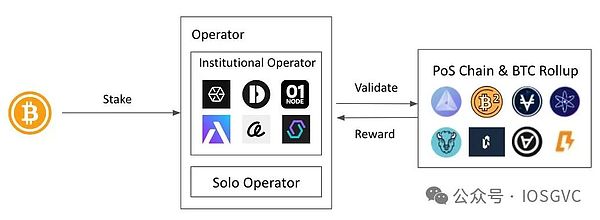
Source: IOSG

3. Re-pled and its ecology
3.1 Liquid Restaking (Liquidity Restaking/LRT)
LRT is a new asset class derived from the tripartite market around EigenLayer.Currently, the total TVL of the LRT protocol is approximately US$6.4 billion, accounting for approximately 41.29% of the EigenLayer TVL.The starting point of LRT is similar to that of LST, mainly to liberate (locked to resolute ETH) liquidity.Due to the different composition of LRT’s underlying assets, LRT is more complex than LST and has a dynamic change.
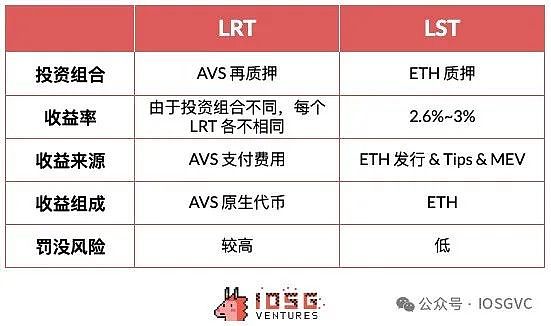
Source: IOSG
The following compares the two:
1. Portfolio
LST’s investment portfolio is only one with Ethereum pledge, but LRT’s investment portfolio is diverse, and can invest funds in different AVSs to provide them with economic security, and naturally have different risk levels.The fund management methods and risk preferences of different LRT protocols are also different.At the fund management level, LST is passive management, while LRT is active management.LRT may provide different management strategies corresponding to different levels of AVS (such as mature AVS vs newly launched AVS) to adapt to users’ earnings/risk preferences.
2. The source and composition of the rate of return, the source and composition of the rate of return
-
The yield of LST is currently around 2.6% to 3%, which comes from the common returns of the Ethereum consensus layer and execution layer, and is composed of ETH.
-
The yield of LRT is uncertain for the time being, but it basically comes from the fees paid by each AVS and may be composed of AVS tokens, ETH, USDC or a mixture of the three.Based on the information we have obtained from our exchanges with some AVS, most AVS reserve several percentage points of the total supply of tokens as an incentive and security budget.If AVS is online before issuing the coin, it may also pay ETH or USDC, depending on the specific situation.
Since it is the AVS token standard, the risk of its token fluctuation will be greater than ETH, and APR will also fluctuate.AVS may also have in and out rotations.Such things can bring uncertainty to LRT’s rate of return.
3. Punishment risk
There are two types of punishments for Ethereum staking: Inactivity Leaking and Slashing, such as missing block proposals and double voting, with high rules certainty.If operated by a professional node service provider, the accuracy can reach about 98.5%.
The LRT protocol requires that the AVS software be coded correctly and there is no objection to the penalty and confiscation rules to avoid triggering unexpected punishments.There is uncertainty in itself because of the variety of AVS and most of them are early projects.Moreover, AVS may change rules as the business develops, such as iterating more functions, etc.In addition, at the risk management level, it is also necessary to consider the escalability of the AVS Slasher contract, whether the penalty conditions are objective and verified, etc.Since LRT serves as the agent for managing user assets, LRT needs to take into account these aspects and carefully select partners.
Of course, EigenLayer encourages AVS to conduct a full audit, including AVS’ code, confiscation conditions, and logic to interact with EigenLayer.EigenLayer also has a veto committee based on multiple signatures to finalize the inspection and control of the confiscation incident.
In general, LRT belongs to an asset management agreement. Based on this market positioning, LRT can further explore related businesses, such as expanding to protocols such as Symbiotic and Babylon, or a DeFi strategy vault similar to Yearn to meet the scenarios and situations of different ecosystems.The needs of users with different risk preferences.
3.2 AVS (Actively Validated Service)
AVS is the object of economic security provided by EigenLayer.According to EigenLayer’s official documentation, AVS covers the following infrastructure: sidechains, data availability layer, new virtual machines, guardian networks, oracle networks, cross-chain bridges, threshold encryption schemes, trusted execution environments, and more.The following table lists more types that may be built on AVS.

Source: EigenLayer, IOSG
Around the core primitives of restaking, EigenLayer has established a good AVS pipeline.Currently, 19 AVSs have launched the main network.
For example, EigenDA is a data availability solution developed by EigenLabs, which is also launched to the market as a flagship AVS.EigenDA’s solution comes from Danksharding, the Ethereum expansion solution.Among them, the concept of data availability sampling (DAS) is also widely used in DA projects such as Celestia and Avail.
For AVS, EigenLayer offers the following benefits:
-
Economic security and node operation services during the project launch stage.During the maturity of the project, EigenLayer can also provide resilient security that can be rented if there is a sharp increase in economic security demand in the short term;
-
AVS’s node verification service is run by Ethereum verifiers. Compared with the project party’s independent operation or centralized node service providers, it can achieve better decentralization;
-
It is possible to reduce verification and operational costs (depending on the situation), reducing marginal costs;
-
The Dual staking model proposed by EigenLayer can provide AVS with certain token utility;
-
Building certain services and products based on the trusted commitments of Ethereum verifiers, such as pre-confirmation;
-
As an EigenLayer ecological project, it has received certain endorsement, marketing support, market exposure, etc.
As a technical solution, AVS is often more natural and concise than L1 and middleware to start its own node network.In addition, it should be recognized that AVS is essentially middleware and infrastructure projects. The logic of investing in AVS should be evaluated based on the logic of evaluating such projects (products, technology, competitive landscape, etc.), and becoming an AVS itself does not provideSpecial differentiation.
As mentioned above, AVS is the re-pled consumer and lender, and is also the core of the tripartite market.The market relies on AVS for payment, which is generally paid in AVS’s native tokens (if the token is not online, it may be in the form of points), which is usually 3%-5% of the total supply of AVS tokens.In the near future, EigenDA will start paying restakers and node operators at a price of 10 ETH per month.EigenLayer itself will also support all early stage AVSs by 4% of its total token supply, helping them get through the cold start period.
From a medium- and long-term perspective, the driving force behind the sustainable development of the EigenLayer ecosystem lies in the demand side, and there needs to be enough AVS to pay for economic security and be sustainable.This is related to AVS’s own business situation and operational capabilities, and will ultimately be reflected in the token price.
The income from Ethereum pledge will exist for a long time and remain in a stable range, while the income of AVS may not be.The tokens of each AVS provide different returns, durability and volatility, and each re-pledger’s risk preferences and pursuit of returns are also different. In this process, there will be spontaneous dynamic regulation of the market (more ETH stakesGoing to an AVS will reduce the yield, prompting the stakeholder to switch to other AVS or other protocols).
3.3 Summary
-
After the airdrop boom faded and the market cooled, EigenLayer’s TVL fell by about 20%, entering the average regression period we had previously predicted.In the long run, we believe that EigenLayer’s re-pled will not be a short-term narrative on the emotional side, but will become a permanent attribute of the Ethereum ecosystem, used to externalize Ethereum’s economic security and help the project start.
-
According to the above, TVL is not the most core indicator for evaluating EigenLayer, the quality of AVS is.If there are more high-quality AVS built on EigenLayer, they will surely bring high returns and TVL will follow.Therefore, the competition between restaking agreements is actually a competition to identify and “invest” in AVS in the early stages.The re-staking agreement will obviously be a winner-takes-all market.
-
For the LRT protocol, TVL is certainly one of the explicit indicators to measure the performance of the protocol, but the number of TVL alone cannot summarize the entirety of a protocol.For agreements such as “save money”, the support of users, especially large accounts, is the core element.Compared with retail investors, large investors have relatively “lazy” funds, have a lower willingness to gain short-term and fast returns, and their risk preference is relatively stable, so they are more likely to stay on the platform for a long time.Liquidity is a top priority for large investors and is related to large investors’ confidence in the project.Therefore, establishing and maintaining liquidity should be one of the primary goals of the LRT protocol.

4. Investment logic and layout
We actively plan the Staking & Restaking tracks before and after the two key time nodes of Ethereum “The Merge” and “Shanghai Upgrade”. In summary, it is mainly based on the following predictions:
-
Ethereum’s “The Merge” means that PoS has become a permanent attribute of Ethereum, and staking is an indispensable part; after “Shanghai Upgrade”, Ethereum staking, as an asset management method, changed from “only entering but not leaving” to”Can be in and out” to achieve a closed loop of capital flow.Two iconic events are the basis for our focused bet on the track.
-
We believe that the pledge track will inevitably develop towards product diversification.The market favors diversified solutions.As a pioneer and absolute leader in the pledge track, Lido will be more cautious in launching new products due to its sensitive position (the community has repeatedly expressed concerns about Lido’s market share of more than 33%), so we believe that with other competitorsWith the introduction of differentiated strategies, Lido’s market share will be on a slow downward trend in the long run.
More than a year has passed, and the market performance has also verified our predictions:

Source: ETH Staking Dashboard by @hildobby
-
The Ethereum staking rate increased from about 12% a year ago to 27.28%, with a growth rate of 227.3%.In the current queue of Ethereum staked, there are 6,425 stakers entering the queue and need to wait 3 days and 14 hours; while there is only 1 staker exiting the queue and there is almost no need to wait (May 31 data).It has been in short supply for a long time.
-
Driven by the Restaking narrative, many LRT protocols (such as Ether.fi, Renzo) have actually become the top stakers of Ethereum.In addition, institutional-level pledge plans and independent pledge plans are also flourishing.Lido’s market share also dropped from its peak of 32.6% to 28.65%.

5. Conclusion
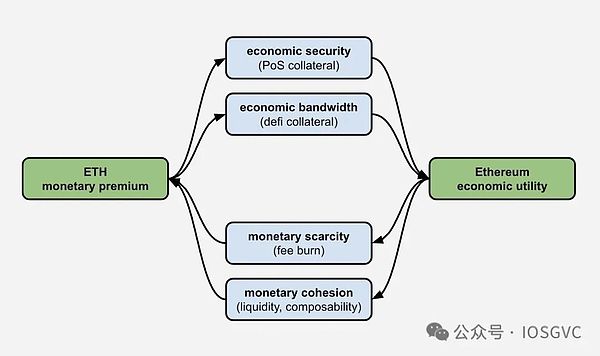
Source: Justin Drake
Looking back at the development history of the Ethereum pledge and re-staking ecosystem, we can clearly see that the value of ETH as a multifunctional asset is constantly strengthened and expanded.From the initial single pricing and Gas function to the diverse roles today, ETH has become an indispensable cornerstone in the crypto economy.
With the continuous expansion of the Ethereum roadmap and the increasingly mature staking ecosystem, the role of ETH has become increasingly important in the entire blockchain industry.Through pledge and re-stake, ETH not only provides a solid foundation for cybersecurity and decentralization, but also demonstrates its unique role in the three attributes of capital, consumption and store of value assets by expanding economic security and enriching the ecosystem..
In the future, ETH may play a more important role in the following aspects:
-
As a value anchor for cross-chain ecosystems: Through re-staking agreements such as EigenLayer, ETH has the potential to become the economic security foundation for a multi-chain world.
-
Promote Composability Financial Innovation: DeFi products based on LST and LRT will be more abundant, providing users with more profit and risk management options.
-
Deepen the integration with traditional finance: The entry channels provided by ETH ETFs and the stability of ETH staking returns may attract more institutional investors and promote the integration of crypto assets and traditional financial markets.
A few predictions:
-
In the future, with the growth of the ETH pledge rate, the pledge income will gradually decrease, and funds will seek more diversified profit composition.As the re-staking solution matures, re-staking will take over the flow of this part of the funds and provide certain additional benefits.(Just like MEV-Boost has become the block building method that almost all validators have defaulted to improve revenue) The proportion of ETH participating in restaking will gradually increase relative to ETH participating in staking.
-
In the field of re-staking, due to the flexibility of LRT in asset management, its positioning will gradually expand from a liquid re-staking platform to a cross-protocol and cross-ecology “asset management center” and a DeFi Hub that connects the past and the future, and even connects to the real world.For example, Ether.fi has launched its crypto-native credit card, linking it with its LRT and Liquid products.In this process, market leaders have high bargaining power when negotiating with upstream and downstream.
We firmly believe that Ethereum will continue to serve as the cornerstone of the decentralized economy, supporting and promoting widespread adoption of global decentralized applications.We will continue to pay close attention to this rapidly growing area and align our investment layout with the future development trends of Ethereum.








